„Ich beschloss, nie mehr für die Regierung zu arbeiten“
Kaung Htet arbeitete als Arzt. Als ihm der Staat verbot, Opfer zu behandeln, wechselte er seinen Beruf – und wurde Fotojournalist.
Der Fotochef der Myanmar Times in seinen eigenen Worten:
„Ich hatte gute Noten in der Schule und meine Eltern wollten, dass ich Doktor werde. Deshalb studierte ich Medizin. Nach meinem Abschluss arbeitete ich an einem Kinderspital in Yangon. Das war 2007. In diesem Jahr geschah auch die Saffran-Revolution, die grössten Proteste in Myanmar seit 1988.
Obwohl ich für ein staatliches Spital arbeitete, mochte ich die Regierung nicht. Ich protestierte zusammen mit Freunden auf der Seite der Mönche. Wir gingen zur Shwedagon Pagoda im Zentrum. Die Mönche waren auf der einen Seite, die Polizei auf der anderen. Dazwischen Barrikaden. Zuerst attackierte die Polizei mit Tränengas, danach schoss sie in die Menge.
Wir rannen weg und wurden von einem Fremden aufgenommen, der uns Tücher gab, um unsere Augen vom Gas zu waschen. Später kam einer der Mönche vorbei. Als er realisierte, dass ich Doktor war, fragte er mich, ob ich einige der Möche untersuchen konnte. Ich folgte ihm ins Kloster. Einige der Mönche waren bewusstlos und hatten schwere Kopfverletzungen. Einige mussten sich stark übergeben. Das ist ein Symptom für gesteigerten Druck im Kopf, eine kritische Situation. Ohne Medizin und Ausrüstung konnte ich ihnen nicht helfen. Ich versprach den Mönchen zurückzukehren und sie zu behandeln.
Ich ging ins Allgemeine Spital von Yangon. Dort traf ich den Gesundheitsminister, der auch Doktor war. Ich erklärte ihm die Situation. Er sagte mir: „Sohn, das ist nicht dein Problem. Geh arbeiten.“ Ich sagte ihm, dass einige der Mönche sterben würde. Ich aber dem hippokratischen Eid verpflichtet sei und jedem Patienten helfen müsse. Er sagte: „vergiss es und geh zurück ins Kinderspital.“
Ich ging zurück. Mit meinem Auto wollte ich Medizin und Ausrüstung ins Kloster bringen. Da realisierte ich, dass meine Vorgesetzten meinen Schlüssel wegnahmen. Ein Kollege sagte mir, dass mehrere Ärzte im Büro warten würden. Dort sagte mir ein Arzt: „Die Regierung hat uns angerufen und sagte, dass ein Doktor im Kloster war. Da du nicht gearbeitet hast, was es klar, dass du das warst. Sei nicht dumm.“ Mein Vorgesetzter sagte mir: „Du weisst nicht mehr, was 1988 passierte. Einige meiner Kollegen damals waren wie du. Ich bin jetzt Arzt, sie sind tot. Ich weinte, als er das sagte.
Schlussendlich war es gut für mich, dass ich nicht zum Kloster zurückkehren konnte. Die Regierung durchsuchte die Kloster und nahm alle Protestteilnehmer fest. Ich schloss, dass meine Möglichkeiten, den Menschen zu helfen, als Doktor sehr limitiert waren. Ich beschloss, nie mehr für die Regierung zu arbeiten.
Später sah ich, dass viele Fotojournalisten Bilder von den Protesten machten. Es gibt ein Foto, das in meinem Kopf bleibt. Ein junger Buddhist der schreit und mit seiner rechten ausgestreckten Hand eine umgedrehte Reisschale hält (siehe unten). Ich verstand, dass ich nur mit einer Kamera solche Geschehnisse dokumentieren konnte.Als Doktor konnte ich den Menschen nicht helfen. Als Fotojournalist würe es mir möglich, solche Vorgänge zu beweisen. Das wurde meine Motivation.
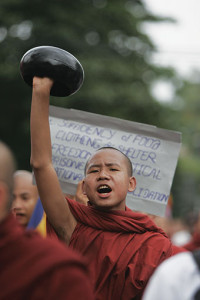
Ich arbeitete während zweier Jahre für eine französische Pharmafirma, wo ich 1000 Dollar pro Monat verdient habe, was viel ist für Myanmar. Ich sparte all mein Geld und kaufte eine gute Kamera und Ausrüstung. Ende 2009 kündigte ich meinen Job und startete als freier Fotograph. Ein Jahr später begann ich als Praktikant bei der Myanmar Times. Jetzt bin ich dort Foto-Chef.
Vor einiger Zeit kontaktierte mich der Fotograph Law Eh Soe auf Facebook, weil er meine Bilder mochte. Erst dann realisierte ich, dass er es war, der das Bild des jungen Mönchs schoss. Er musste aus Myanmar flüchten. Zuerst nach Thailand, dann in die USA. Ich bin sehr glücklich, dass ich ihn im November in Myanmar treffen werde.“
Einige Bilder aus Kaung Thets Portfolio:
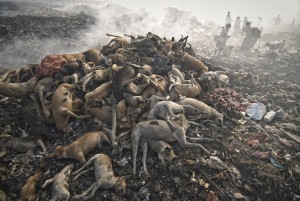
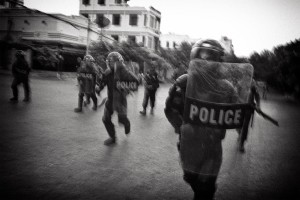
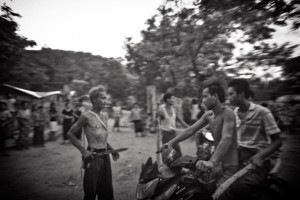
English version
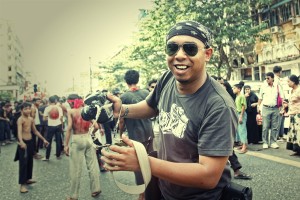 Kaung Htet, photo editor of the Myanmar Times, recounts why he changed his career from medical doctor to photo journalist:
Kaung Htet, photo editor of the Myanmar Times, recounts why he changed his career from medical doctor to photo journalist:
“I had good marks at school and my parents wanted me to become a doctor. Therefore, I attended med school. After graduation, I worked at the Yangon children hospital. That was in 2007. In that year, the Saffron Revolution happened. That was the biggest uprising since the protests in 1988.
Even though I was working for the state hospital, I was unhappy with the government. I followed the monks together with my friends from med school. We went to Shwedagon Pagoda to demonstrate.The monks were on one side, the riot police on the other one. Quickly, the police dropped tear gas bombs. Then they shot into the public.
We ran away and stayed at a foreigner’s place who was so kind to give us a towel to clean our eyes from the gas. Later, one of the monks came to me and, after realizing I was a doctor, asked me to have a look at some of the monks. I followed him into the monastery. Some were unconscious, badly beaten in the head. Some of them were vomiting heavily. This is one of the symptoms when the pressure in the head is increasing. It shows the patient is in a dangerous condition. We did not have any medicine or equipment with us. I promised the monks I would return and help them.
I went to Yangon general hospital. There, I met the minister of health who was also a medical doctor. I explained the situation to the minister. He told me: “Son, this is not your problem. Go back to work.” I told him that as a doctor I was under the hippocratic oath. That some of the monks would not survive. He said: “forget it and go back”.
I wanted to to back to the children’s hospital and get my car and bring medicine and equipment to the monastery. I had to realize, that my superiors took my car key. One of the specialists told me that professors and the superintendant were waiting for me at the office. They were very humble. They said: “We got a call from the government that a doctor was in the monastery. They knew it was me, as I was not on my duty. “Do not be foolish”, they told me. One of the professors told me: “You do not remember what happened in 88. Some of my colleagues back then were like you at the time. Now I am a professor, some of my colleagues were even killed.”
I cried when he said that.
In the end it was fortunate for me that I could not held my promise to the monks and return to the monastery. The government raided the monasteries and arrested everybody. I concluded that as a doctor working for the government, your capability to genuinely help people is very limited. I got a guilty conscience because I could not help them. I decided that I would never work for the government anymore.
Later, I saw that many photojournalists pictured the protests. There was one photo that I still remember. A young Buddhist shouting slogans with a bowl on his fist (see below). I realized that only if I had a camera I could document such events. As a doctor I could not help them. As a photojournalist I could get evidence from the scenes. That became my motivation.

I worked for a French pharmaceutical company for two years, where I got 1000 Dollars a month, which is a lot in Myanmar. I saved all the money and bought good camera equipment. In the end of 2009, I quit the French company and started as a freelance photographer. In 2010 I joined the Myanmar Times as an intern. Now I am still working there as the head of the photogpraphy department.
Some time ago, a photographer called Law Eh Soe contacted me on Facebook because he liked my pictures. Only then did I realize that it was him who took the picture with the young monk. He had to flee from the country, first to Thailand, then to America. I am very happy that I will meet in November, when he will be able to return to Myanmar.
Some images of Kaung Htet’s portfolio:



Schreibe einen Kommentar